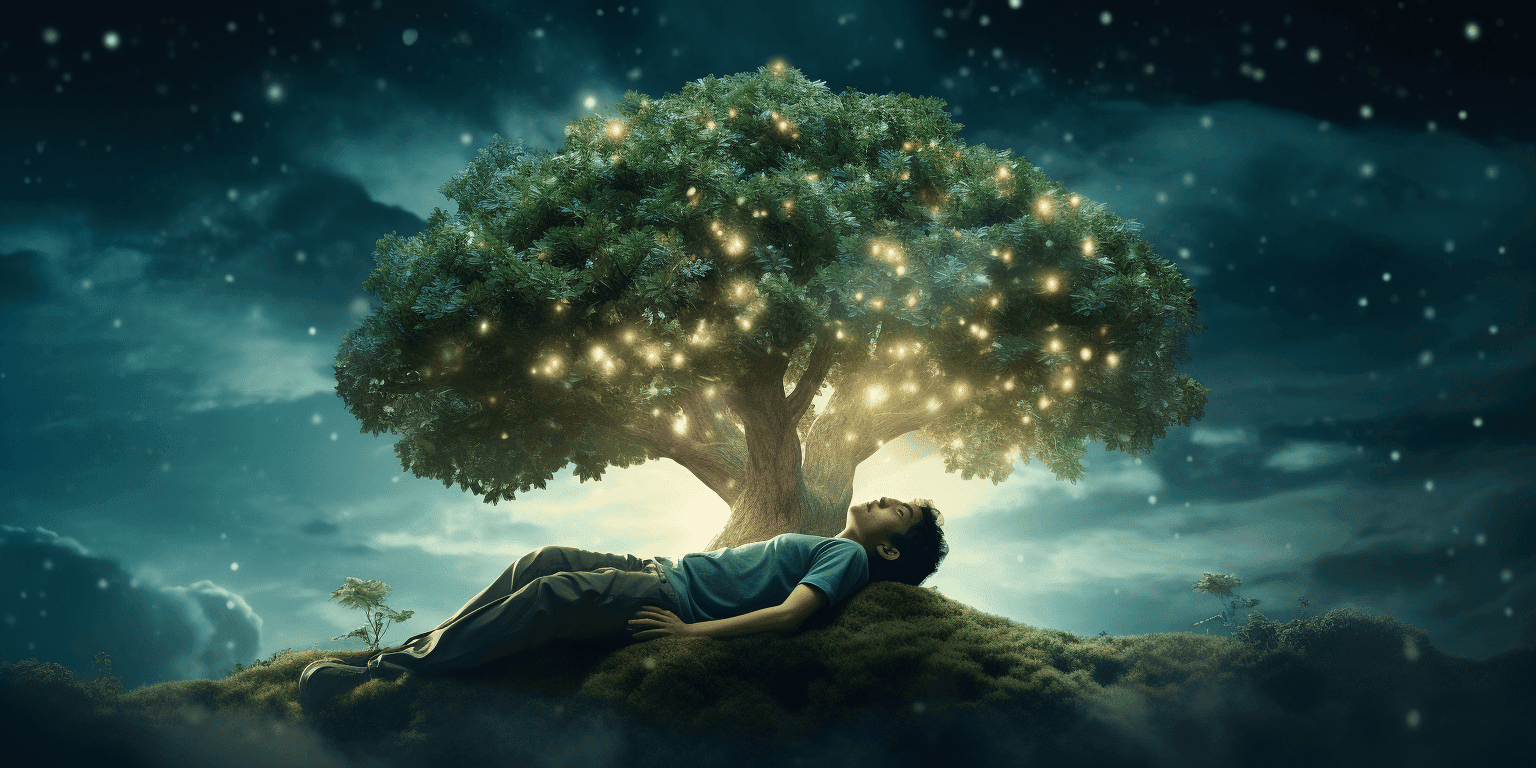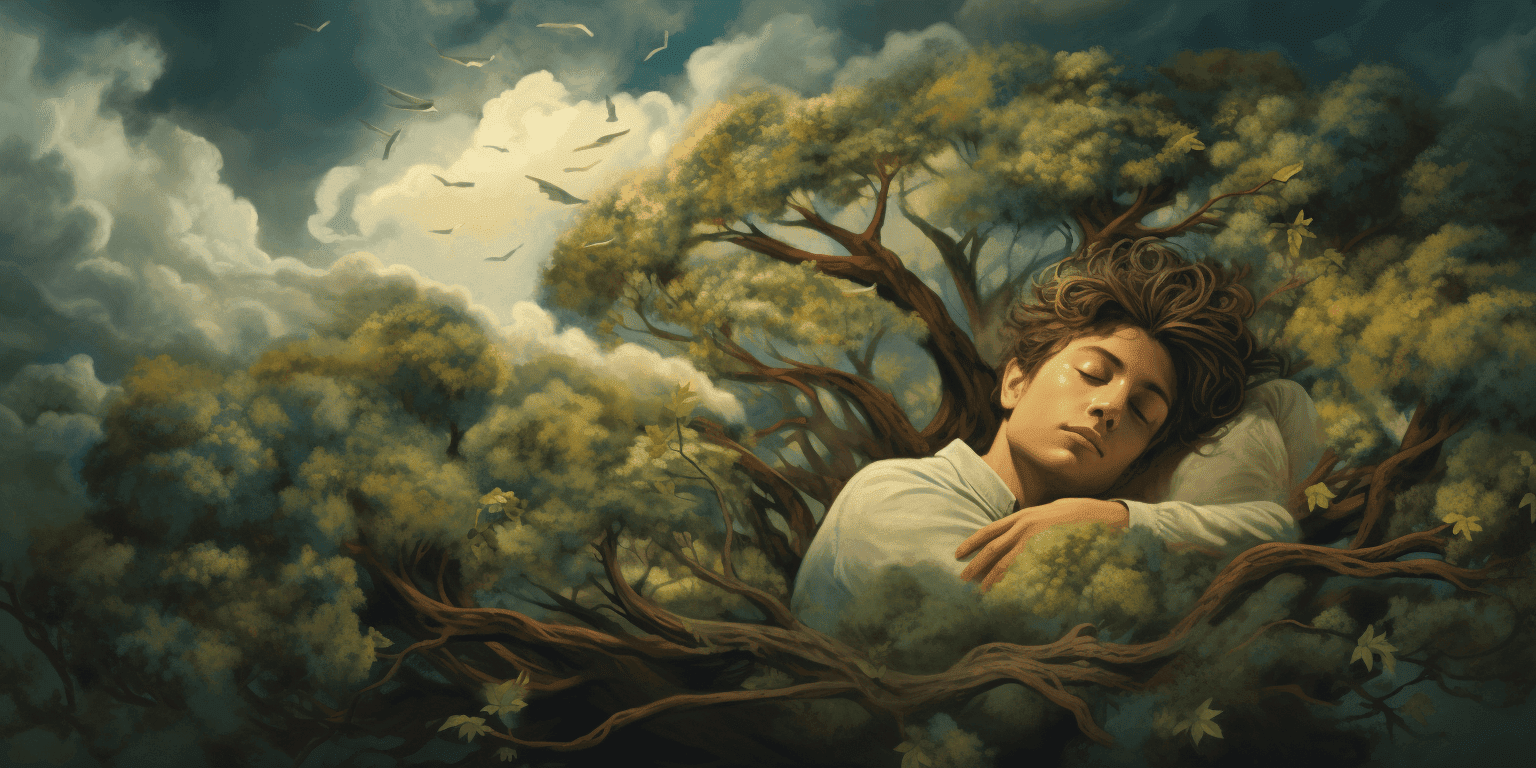Dreams About Trees: Psychological Interpretations
Many of nature’s gifts come from trees. Throughout human existence, trees– from the oldest oaks to the slimmest pines– have provided us with food, shelter, and fuel. Trees in dreams thus abound with symbolism, carrying profound implications for our minds.
Trees in dreams represent the process of self-growth, signifying aspects of our psyche most closely tied to stability, vitality, and slow changes. As ancient denizens of nature, trees also represent our primordial instincts and desires.
Dreams about trees thereby carry many potential insights into the state of our thoughts and emotions. As such, psychological perspectives on dream interpretation can help unravel and uproot their many interesting implications.
Psychological Overview of Trees in Dreams

Trees have been the subject of psychological study. With the ubiquity of trees in nature, various cultures have ascribed trees with deep symbolism, often revolving around trees’ fascinating representation of the cycle of life.
Trees have therefore become embedded into human identity. Trees are the source of concepts like a “family tree” or a “decision tree.” Many can recall a memorable tree from their childhoods, or the woods and orchards of their treasured communities.
One study even finds that trees and plants have an observable effect on human motivation and productivity. Intimately connected to our natural senses, trees also have a calming effect on the mind.
Hence, the manifestation of trees in our dreams can harbor profound insights into the state of our psyche. In fact, various psychological approaches to dream interpretation have studied the meaning of dreams about trees.
The species, color, appearance, condition, and specific ways we interact with the trees in our dreams can each tell us something about our minds, emotions, and experiences in waking life:
If we dream about approaching a withered tree, then this can indicate worrisome anticipation or dread for something or someone in our waking lives. As with any representation of decay and loss of life in dreams, this can mean stress, loss, and anger.
A dream of a lush and bountiful forest, in contrast, can signify a state of peace and satisfaction with oneself and place in life. An abundance of trees with healthy green leaves and strong trunks can reflect the stability we find in others.
Dreaming of a tree teeming with arboreal animals like monkeys, squirrels, and bats may embody a wholeness with nature and one’s surrounding environment. It suggests a harmony between the self and the outside world.
Dreams About Trees in Jungian Analysis

According to Jungian analysis, dreams are messages from the unconscious that indicate our psychic state and progress toward self-growth. Decoding these messages often involves examining the symbolic value of the specific elements of our dreams.
To do so, Jungian analysis interprets dreams through the language of archetypes. Archetypes are universal symbols with meaning drawn from the collective unconscious as well as our personal traits and characteristics.
The more ancient and pervasive the real counterpart of a dream element, the stronger their symbolic value and affinity to a specific archetype. Trees in dreams are a quintessential example of this, often representing the Great Mother archetype.
Trees in Dreams and the Great Mother Archetype
The Great Mother archetype is closely tied to fertility, abundance, new beginnings, and the cycle of life and death. As a collective symbol, the Great Mother has often been represented through trees, such as the Tree of Life in the Garden of Eden.
Trees in dreams thereby signal our relation to the aspects associated with the Great Mother. The species, condition, and personal associations with the trees in our dreams can all potentially reveal our relationship with our own vitality, self-progress, and energy.
As an example, a dream involving a tall and imposing tree can reflect our inner robustness. Likewise, a dream of a tree with blooming flowers or bearing fruits can signify relief and joy from a recent life-changing decision.
In contrast, dreaming of a dying tree can denote feelings of unhappiness or stress concerning our health and tolerance for life’s challenges. This can also indicate the fear of losing our mental and emotional stability.
Dreams About Trees in Freudian Psychoanalysis

A classic approach in dream interpretation, Freudian psychoanalysis views dreams as profound representations of our instinctual impulses and deeply repressed desires.
The nature of these impulses and desires is often deciphered through sexual symbolism. This symbolism, while seemingly strange at first, can be insightful, often revealing many unresolved and suppressed wishes.
Dream elements that bear a strong resemblance to genitalia are, according to Freudian psychoanalysis, loaded with many psychological implications. The more personally prominent this element, the closer its affinity to the dreamer’s sexual impulses.
Dreams about trees, as such, have featured prominently in classic cases of Freudian psychoanalysis. Because they resemble male genitalia, trees in dreams have been interpreted in interesting ways relating to sexual symbolism.
Trees in Dreams and Freudian Sexual Symbolism
Trees bear the strongest resemblance to male genitalia or the phallus. The phallus, in Freudian psychoanalysis, is the most potent representation of the male psyche, with traits relating to assertiveness, dominance, aggressiveness, and control.
Hence, classic cases of Freudian psychoanalysis have interpreted trees in dreams as manifestations of the phallus. The specific type, condition, and appearance of the tree in our dreams can further influence its meaning.
For instance, dreaming of a forest of verdant trees can reflect a deep wish to be more in control of our lives. We may be pining for the traditionally masculine traits that Freudian psychoanalysis ascribes to the phallus: strength, aggression, and initiative.
The fruits of a tree can also carry meaning. If we dream about a fruiting tree, then the fruits can reflect a subconscious desire for offspring. On the contrary, if the fruits of this tree are rotting, then this can indicate a disdain for children.
Dreams About Trees in Gestalt Therapy

In Gestalt therapy, dreams are seen as projections of the dreamer’s self. That is, the elements and situations within a dream represent parts of us that need recognition, acceptance, and resolution.
Trees in our dreams would thus be interpreted as embodiments of specific aspects of us. These can range from personality traits to unresolved memories and experiences. Understanding the trees in our dreams is understanding ourselves.
As an example, if we dream of walking through a forest, then the condition, vibrance, and density of the forest can indicate different aspects of ourselves. If the forest is snowy and the trees are dead, then this can mirror deep dissatisfaction and sadness.
Likewise, if we dream of a tree we recognize from our childhood, Gestalt therapy would invite us to unravel our emotional connection with this tree and the details from our childhood that we associate with it.
By consciously interfacing with the most prominent elements of our dreams, we come to realize repressed or neglected facets of ourselves. Gestalt therapy has plenty more techniques for understanding the meaning of trees in our dreams.
Gestalt Techniques for Interpreting Trees in Dreams
Gestalt therapy advocates the process of direct engagement to understand the meaning of our dreams. This means consciously engaging with the most remarkable details of our dreams through highly personalized and interactive techniques.
Role-playing is one such technique, which is “acting out” or personifying the most significant objects or creatures in our dreams. Consciously seeing ourselves in these elements may help clarify the aspects of ourselves that these dream elements project.
In one case of Gestalt therapy, a dreamer was asked to role-play a tree in their dream. By imagining themselves in the place of the tree in their dream, they were able to draw out the emotions and traits that the tree embodied.
Another technique is dialoguing. Dialoguing means speaking with the elements in our dreams. We may ask these elements questions, argue with them, or even joke with them. This allows us to realize the traits of ourselves that these elements embody.
Gestalt therapy may thereby prompt us to converse with the tree or trees in our dreams, especially if we carry an emotional attachment to a specific tree from our memory. Our conversation can thus expose unresolved emotions and unknown thoughts.
Conclusion
Being inseparable components of nature, trees carry an interesting connection with our psychology. Likewise, in dreams, trees bear a plethora of psychological implications, from manifestations of our mental energy to symbols of deeply repressed emotions.
While the interpretations of the meaning of trees in our dreams are quite diverse and often contingent on our unique individual circumstances, the process of interpreting them can be a springboard toward self-understanding and self-growth.

